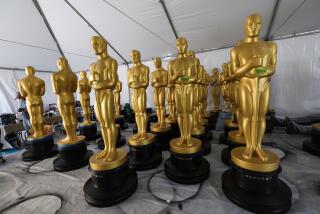Academy Museum will roll out a digital red carpet before the Oscars
The Academy Museum of Motion Pictures won’t open until Sept. 30, but you can “visit” as soon as April. The museum held an online media preview Wednesday, during which it announced that virtual programming will start on its website April 22.
The museum is the public face of the Academy of Motion Picture Arts and Sciences. The 93rd Oscars ceremony will spotlight the film industry on April 25, and the museum is rolling out the virtual red carpet a few days before with screenings, panel discussions, educational workshops and other online events.
“The Academy Museum of Motion Pictures has long been a dream of the academy, the city of Los Angeles and the film industry,” Director Bill Kramer said in his welcome address Wednesday. Drawing on the academy’s film archive and its Margaret Herrick Library of works on paper as well as participation from academy members across its branches, the museum will be “unparalleled in what it will offer,” Kramer said.
After several false starts — the museum originally planned to open Dec. 14, 2020, and the pandemic pushed the opening to April 30, 2021, then Sept. 30 — Kramer said museum officials were confident it will open in September.
“We are prepared to open and fully ready to open,” Kramer said. “We will continue to monitor the health and safety components of opening in September,” he added, “but we’re feeling very good about it.”
The first virtual event in April will be a conversation with groundbreaking women in the industry, hosted by museum trustee Diane von Furstenberg and moderated by the museum’s chief artistic and programming officer, Jacqueline Stewart. “Breaking the Oscars Ceiling” will feature Whoopi Goldberg, Marlee Matlin, singer-songwriter Buffy Sainte-Marie as well as Sophia Loren, who will receive the museum’s inaugural annual Visionary Award at its first fundraising gala Sept. 25.
The website also will showcase an interactive timeline of Oscars history, previewing a similar timeline in the museum when it opens.
In the days leading up to the Oscars, the museum will screen online writer-director Dee Rees’ 2011 “Pariah,” with a cast and crew discussion afterward, as well as writer-director Alfonso Cuaron’s 2001 “Y Tu Mamá También.” Cuaron will discuss the film in Spanish, with English subtitles, with cinematographer Emmanuel “Chivo” Lubezki afterward.
Kramer said that the museum chose those films because they’re represented in the core exhibition “Stories of Cinema.”
“We wanted components of our core exhibition and to bring them to life through these virtual programs,” he said.
Pre-opening educational programs include a conversation with six Black visual effects artists and a day of art-making workshops, live performances and other events related to the work of Hayao Miyazaki. The retrospective “Hayao Miyazaki” is the museum’s inaugural special exhibition and is being touted as the first major U.S. exhibition of the Japanese filmmaker’s work.
Stewart called the slate of pre-opening and in-person planned programming “dynamic, diverse and deeply grounded in the history and artistry of filmmaking.”
A pre-opening, virtual “In Conversation” film series, Stewart said, “will address intersections between filmmaking and social change, directors’ inspiration, creative collaborations and so much more.”
Wednesday’s event included a virtual tour of the museum’s galleries, seen in renderings and led by museum trustee Laura Dern. Prerecorded comments were from academy members including Guillermo del Toro, Spike Lee and Rita Moreno — all of whom are highlighted in the museum’s exhibitions — as well as museum board vice chair Miky Lee. Pritzker Prize-winning architect Renzo Piano, who designed the 300,000-square-foot, $482-million museum, participated in the preview as did Kulapat Yantrasast, whose Culver City-based wHY Architecture designed the gallery interiors.
When it opens, “Stories of Cinema” will address the evolution of filmmaking across three floors of the museum, with deep dives into different facets, including directing, screenwriting, cinematography, sound design, costume design, hair and makeup, and visual and special effects. Conceptual exhibits will focus on topics such as sci-fi/fantasy characters and worlds. The museum will refresh gallery content every eight to 12 months, Kramer said, and it will rotate in guest curators from the industry. The first three will be filmmakers Lee and Pedro Almodóvar and Icelandic composer Hildur Guðnadóttir.
The museum’s fourth floor will be devoted to special exhibitions. After “Hayao Miyazaki,” the museum will present “Regeneration: Black Cinema 1898-1971” in 2022.
All of Hollywood’s narratives, including the industry’s problematic history regarding racism, diversity and lack of inclusion, will be addressed throughout the museum, Kramer said. A gallery about the history of the Oscars will address, among other things, the 1940 treatment of Hattie McDaniel. The “Gone With the Wind” actress was the first African American to win an Oscar but was made to sit in the back of the room at the ceremony. An Impact/Reflection gallery will address how movies mirror and impact our world, touching on the Black Lives Matter and #MeToo movements as well as the topics of labor relations and climate change. An animation exhibit will address racism and sexism in the field; an exhibit on makeup will address the history of blackface and yellowface.
“We’re a museum about cinema, the art of films, our history, our future,” Kramer said in a question-and-answer session after the presentation. “And given that mandate — the mission that we have to celebrate and create moments of discovery around moviemaking — we can’t erase our past.”
It’s a particularly relevant time to address such topics, Stewart said in the Q&A. “This is a moment when so many institutions are thinking through these questions.”
“It’s incredibly important too,” she added, “that we’re working with people who have contributed to filmmaking in so many different areas, all areas of the craft.”
The museum will lean heavily on its two state-of-the-art movie theaters to host in-person events. Screenings and discussions with movie industry figures will be held in the 1,000-seat David Geffen Theater and 288-seat Ted Mann Theater.
Is the museum concerned that visitors might be wary of sitting in a theater?
“I think we have to keep an eye on what’s possible when we open, given the pandemic,” Kramer said in an interview. “But we have both in-person and virtual options in front of us.
“Our hope is that people will be very eager to return to theaters. We do have the ability to do timed ticketing and staggered seating, so if we need to employ those visitor services options, we will to make the spaces safe.”
Construction of the museum — a restored 1939 May Co. building and Piano’s new globe-shaped theater, both next to the Los Angeles County Museum of Art on Wilshire Boulevard — is complete. The ground-level restaurant, cafe and retail store are nearly complete. Installation of the exhibitions is nearly finished but for objects that will be placed in vitrines and cases closer to the opening.
“Our exhibition spaces are built out,” Kramer said, “and look absolutely beautiful.”
More to Read
The biggest entertainment stories
Get our big stories about Hollywood, film, television, music, arts, culture and more right in your inbox as soon as they publish.
You may occasionally receive promotional content from the Los Angeles Times.











